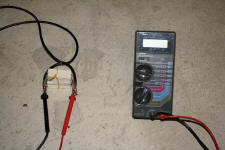|
Design:
After listening to John Lyngdal's
presentation at NARCON 2010, I came to more fully appreciate the amount of
voltage drop typically present during a cluster launch and its negative
effects on igniter timing and reliability.
Resistance of power wiring is critical. In most launch systems there
is more voltage drop due to power wiring than the battery.
For 10 ft leads there is a 20
ft round trip for the circuit.
16awg, used in many launch systems, has 4ohms of resistance per
1000ft.
16awg, 10ft lead, 20ft x 0.004ohms=0.08ohms or about 1V drop per 12.5A
current due to leads
10awg has 1ohm of resistance per 1000ft.
10awg, 10ft lead, 20ft x 0.001ohms=0.02ohms or about 1V drop per 50A current
due to leads
Was concerned that leads heavier than 10awg would be prone to pulling out
the rocket's igniters.
Wanted wires that could follow the rocket for 2-3 feet as it lifted off.
Going for simplicity and light
weight, chose a high output Lipo battery and heavy gauge power wires.
Considered but did not use capacitors and lead acid batteries.
The Turnigy (hobby RC) wire has very fine strands and silicone
insulation, making it far more flexible than any other 10awg wire I have
ever seen.
Choose a
14.8V Lipo battery rated for very high current output (200A+) to stay
compatible with 12V components and igniters while delivering lots of power
from a light weight battery (only 1.3lbs). |





